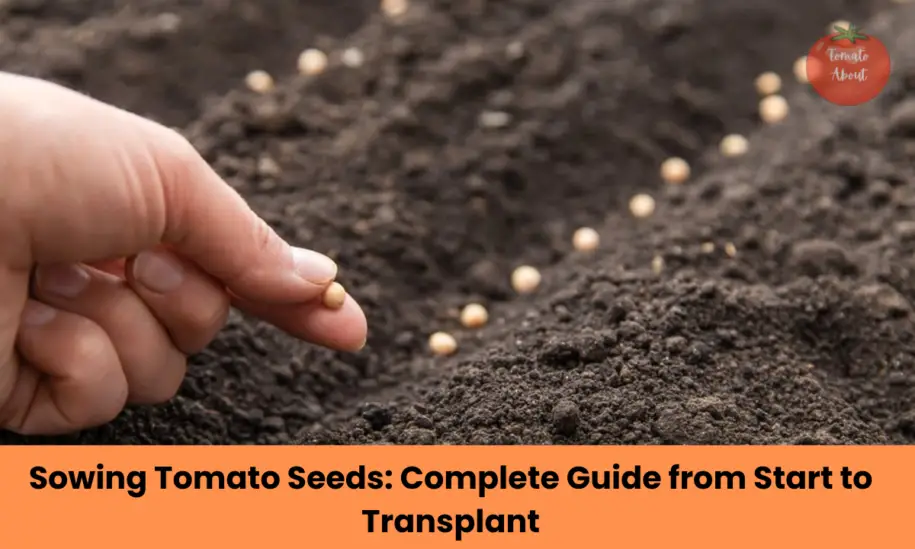As every seasoned gardener knows, sowing tomato seeds at the right time and following proper care practices is crucial to growing a successful tomato crop. Though buying starter plants from a nursery can be easier for beginners, starting tomatoes from seed allows you to choose from a wider variety of heirloom varieties. Plus, sowing your own seeds is highly rewarding when those tiny seedlings mature into fruit-laden, vigorous tomato vines.
In my experience, growing tomatoes from seed does require more time and effort compared to transplanting nursery starts. However, the yields make it well worth the extra work. By using proper sowing techniques and providing attentive care as the seedlings develop, you can give your tomatoes the best start possible.
In this complete guide, I’ll share everything you need to know about sowing tomato seeds for healthy, prolific plants. We’ll cover tips on choosing varieties, when to plant, sowing techniques, hardening off, transplanting, and more. Let’s dive in!
Selecting the Best Tomato Varieties for Sowing from Seed
One of the distinct advantages of growing tomatoes from seed is the incredible range of varieties you can choose from. While most nurseries stick to popular standards like Better Boy, Celebrity, and Beefsteak, seed catalogs offer hundreds of heirloom, hybrid, paste, cherry, and sauce types.
In my experience, the Brandywine and Cherokee Purple heirlooms produce exceptionally rich, complex flavor. For saucing and canning tomatoes, try Amish Paste or San Marzano. If you want bite-sized tomatoes, go for prolific cherry types like Sungold and Supersweet 100.
No matter which you choose, look for varieties described as vigorous growers that resist disease. This will increase your chances of success when sowing from seed.
When to Start Tomato Seeds Indoors
One of the most common tomato sowing mistakes is starting the seeds too early indoors. Though it’s tempting to get a head start, tomatoes grow best when sown 6-8 weeks before your average last spring frost date.
Sowing earlier often results in tall, leggy seedlings due to inadequate sunlight from windows or grow lights. The plants outgrow their pots and require a lot of leggy stems buried when transplanting.
For me, tomato seeds sown in late March or early April reliably produce stocky seedlings that transplant well here in Zone 5b. The best way to determine your ideal sowing window is to check your average last spring frost date, then plan to sow seeds 6-8 weeks beforehand.
Choosing Containers for Sowing Tomato Seeds
You can sow tomato seeds in almost any container that:
- Has drainage holes in the bottom
- Is at least 2 inches deep
- Is large enough to hold the seed starting mix
However, I’ve found that wide, shallow flats or trays work best because they give those rapid-growing tomato roots ample room to expand. Standard 10×20 inch trays allow you to sow several seeds together and then easily separate them when the time comes.
Individual cells like those in seed starting trays also work well. Just be sure the cells are at least 2 inches deep and 2 inches wide.
Creating an Ideal Seed Starting Mix
The seed starting medium you choose is critical because it serves as the foundation for your tomato plants’ early root development. A sterile, nutrient-lite mix prevents damping off disease and lets you control nutrition precisely.
My favorite DIY mix contains:
- 1 part sphagnum peat or coco coir – Provides moisture-retention
- 1 part perlite or vermiculite – Aerates the soil
- 1 part compost – Supplies nutrients
You can certainly purchase premixed seed starting blends, but make sure they contain peat/coir as well as perlite/vermiculite. I suggest steering clear of potting soils, which are too dense.
Sowing Tomato Seeds with Proper Depth & Spacing
Proper sowing technique helps ensure even germination and healthy seedlings. Follow these steps for the best results:
1. Use a Seed Sowing Mix
Sow seeds in a lightweight, soilless sowing mix. This provides good drainage and airflow that tomato seeds need. Popular options are vermiculite, perlite, coco coir, or a peat-based mix.
2. Fill Seed Trays
Fill seed trays 3⁄4 full with sowing mix. Gently firm it down before sowing. Leave 1⁄4 inch (6mm) space at the top.
3. Space and Sow Seeds
Tomato seeds can be sown directly in cells or flats. If sowing in cells, sow 1-2 seeds per cell. For flats, space seeds 1 inch (2.5cm) apart in rows 2 inches (5cm) apart. Sow seeds 1⁄4 inch (6mm) deep.
4. Cover Seeds and Water
Cover tomato seeds lightly with more sowing mix or vermiculite. Gently water with a fine mist to moisten the mix. Don’t saturate it.
5. Provide Warmth
Place seed trays in a warm spot around 70-80°F (21-27°C). Good options are the top of a fridge or on a heating mat.
6. Remove Covering
Once sprouted, move to full light and remove any coverings. Grow lights work well if natural light is limited.
Providing the Proper Conditions for Germination
From the time those tomato seeds are sown until the seedlings emerge, keep them in a warm, bright spot. Here are the optimal conditions for robust tomato seed germination:
- Soil temperature – Maintain a constant soil temperature of 75-90°F. Fluctuations can prevent germination.
- Air temperature – The ideal air temperature is around 70°F during the day and 60-65°F at night.
- Light – Place seeds near a sunny window or under grow lights for 14-16 hours per day.
- Moisture – Keep the soil evenly moist but not saturated.
Monitor moisture daily and provide seedlings with plenty of light as soon as they emerge.
How to Care for Tomato Seedlings Under Lights
Once the seedlings emerge, it’s vital to provide adequate light, warmth, and nutrition to prevent stretchy, weak growth. Here are my tips for proper tomato seedling care:
- Place seedling trays 2-3 inches below LED grow lights. Leave lights on 14-16 hours per day.
- Maintain air temperatures of 65-70°F during the day and 60-65°F at night.
- Water when the top inch of the mix becomes dry. Use bottom watering to avoid mold.
- Feed weekly with a half-strength liquid tomato fertilizer once true leaves appear.
- Gently circulate air daily to strengthen stems.
With attentive care, your tomato seedlings will grow stocky and strong within 6-8 weeks.
Hardening Off Tomato Seedlings
A week or two before transplanting your tomato starts outside, it’s essential to begin the hardening-off process. This transitions the tender plants from indoor to outdoor conditions.
To harden off tomato seedlings, follow these steps:
- Move plants to a sheltered, shady spot outdoors.
- Provide 1-2 hours of direct sun the first day, increasing an hour daily.
- Bring plants back indoors at night until the risk of frost passes.
- Allow plants to remain outdoors at night for 1-2 days before transplanting.
Hardening off toughens cell walls and prevents shock when tomato seedlings are finally planted in the garden.
Transplanting Tomato Seedlings to the Garden
Your seeded tomatoes are ready for transplanting once they’ve developed 5-7 true leaves and the nights stay above 45°F. Follow these tips for a successful transition to the garden:
- Harden off plants as described above 7-10 days prior to transplanting.
- Dig holes 18-24 inches apart in sunny locations with fertile soil.
- Bury leggy stems horizontally in a deep trench with just the top 2-3 sets of leaves exposed.
- Water transplants thoroughly.
- Provide shade for newly transplanted tomatoes until established.
- Mulch around plants to retain moisture and reduce weeds.
Common Problems When Growing Tomatoes from Seed
Even with the best sowing practices, issues can pop up when growing tomatoes from seed. Here are some common problems and how to resolve them:
- Leggy seedlings – Insufficient light, overcrowding, or excessive heat. Provide 14-16 hours of direct light daily, space plants, and reduce temperature.
- Damping off disease – Fungal issue caused by excessive moisture on seedlings. Allow mix to dry between waterings and increase air circulation.
- Blossom end rot – Caused by inconsistent watering leading to calcium deficiency. Maintain even moisture and add calcium supplements if needed.
- Wilting – Often a sign of drought or root damage during transplanting. Water deeply and regularly. Handle seedlings gently when transplanting.
- Poor fruit set – Results from night temperatures exceeding 75°F or extreme temperature shifts. Not much can be done aside from selecting more heat-tolerant varieties.
Key Takeaways: Sowing Tomato Seeds
- For outdoor growing, sow 6-8 weeks before the last frost date.
- For greenhouses, sow seeds in mid to late February.
- Use a lightweight sowing mix like vermiculite or coco coir.
- Sow 1-2 seeds per cell or space 1 inch apart in flats.
- Cover seeds lightly and keep warm around 70°F (21°C) to sprout.
- Once sprouted, move to full light and care for seedlings until transplanting outdoors after hardening off.
By mastering the entire process – from sowing seeds to gathering ripe tomatoes – you’ll enjoy one of the best homegrown harvests possible. Nothing beats the satisfaction of turning tiny seeds into bushels of juicy, vine-ripened tomatoes!
Let me know if you have any other tomato seed sowing tips in the comments below! I’m always looking to refine my techniques.
Frequently Asked Questions
How can I get an early start on tomato seeds indoors?
Consider using a heat mat under seeded trays to provide bottom warmth, encouraging faster, more uniform germination. Maintain a soil temp of 80-90°F until sprouted. Just be sure to monitor moisture levels closely when using bottom heat.
What are some good heirloom varieties for sowing tomato seeds?
Some top heirloom tomatoes to try sowing from seed include Brandywine, Cherokee Purple, Mortgage Lifter, Green Zebra, and Black Krim. Heirlooms offer wider flavor diversity but may require staking for support. Ensure your growing season is long enough when choosing heirloom varieties.
When should I apply fertilizer to my tomato plants?
Once planted in the garden, side-dress tomato plants with a balanced fertilizer containing nitrogen when the first fruits begin to form. Apply again every 3-4 weeks throughout the growing season for continual feedings. Avoid high-nitrogen fertilizers after August to help plants slow growth and focus energy on fruit ripening.



